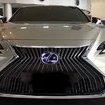Search the Community
Showing results for tags 'power'.
-
https://asia.nikkei.com/Business/Technology/Japan-drone-submarine-eyes-16-hour-dive-with-plastic-battery?utm_campaign=RN%20Subscriber%20newsletter&utm_medium=JP%20update%20newsletter&utm_source=NAR%20Newsletter&utm_content=article%20link&del_type=4&pub_date=20200721090000&seq_num=13&si=%%user_id%% Japan drone submarine eyes 16-hour dive with plastic battery Sanyo tests rechargeable prototype with Kawasaki's unmanned vessel Sanyo Chemical Industries' all-polymer battery can power Kawasaki's unmanned submarine for 16 hours on one charge. YUKI MURAKAMI, Nikkei staff writerJuly 21, 2020 00:29 JST KYOTO -- Sanyo Chemical Industries' rechargeable battery made almost entirely of plastic is now powering an unmanned submarine by Kawasaki Heavy Industries in a test run, with the promise of doubling the vehicle's operation range to 16 hours. The trial presents the first commercial use of the all-polymer device made by Sanyo subsidiary APB. The battery, whose electrolytes are also made of resin, lasts twice as long as its lithium-ion cousin and boasts cheaper production costs and greater resistance to fires. Kawasaki's autonomous underwater vehicle is designed to inspect oil pipelines and other deep sea equipment. Due to the nature of the work, an internal battery would be subjected to high pressures. The all-polymer battery can withstand depths of more than 3,000 meters. APB's battery can power the vehicle for about 16 hours on a single charge, up from roughly eight for a lithium-ion battery. Mass production for the all-polymer battery is said to cost 90% less than for a lithium-ion counterpart due to the simplicity of the manufacturing process. APB, is setting up a plant in Japan's Fukui Prefecture. Full-scale production will be ready around fall 2021, with sales to begin before the fiscal year ends in March 2022. The aim is to develop a business worth hundreds of billions of yen (100 billion yen equals $934 million) within five to 10 years. The operation will focus on stationary power storage for buildings, but batteries for undersea drones have become feasible as well. APB has raised roughly 9 billion yen from eight investors through June, including trading house Toyota Tsusho and energy major Eneos Holdings. Both Nissan Motor and Sanyo have licensed polymer battery technology to APB to accelerate development.
-
https://asia.nikkei.com/Business/Companies/Toshiba-s-megawatt-fuel-cells-have-enough-juice-to-power-a-factory?utm_campaign=RN%20Subscriber%20newsletter&utm_medium=JP%20update%20newsletter&utm_source=NAR%20Newsletter&utm_content=article%20link&del_type=4&pub_date=20200722090000&seq_num=10&si=%%user_id%% Toshiba's megawatt fuel cells have enough juice to power a factory Hydrogen system bolsters Japan's efforts toward renewables Toshiba looks to expand the market for its hydrogen power systems. TAKAYUKI YAO, Nikkei staff writerJuly 22, 2020 05:13 JST TOKYO -- Toshiba is set to roll out a hydrogen-powered fuel cell system capable of generating enough electricity to power 1,000 homes, or an entire factory or hospital in a boost to a government push of the zero-emission energy source. Toshiba Energy Systems & Solutions has developed a 1 megawatt system consisting of at least 10 of its existing 100kW hydrogen fuel cells and will start selling it as early as this fiscal year. A megawatt equals 1,000kW. Other than Canada's Ballard Power Systems, there is no other supplier of hydrogen fuel cells with such capacity, according to the Toshiba subsidiary. Factories and hospitals generally require power capacity of 1MW to 2MW to operate. Japan has been pushing hydrogen as a more environmentally friendly alternative to carbon-based fuels. Hydrogen can supplement solar and wind power supply, which tends to be unstable, generating electricity at night for those who rely on solar during the day, for instance. Another idea is to produce hydrogen using solar energy and generate power from that hydrogen later. Because hydrogen can be stored, it can be an emergency power source. One issue is cost. Electricity produced by hydrogen fuel cells for industry users costs about 40 yen (37 cents) per kilowatt-hour by one estimate, roughly twice as expensive as conventional electricity. That figure is also higher than rechargeable batteries. Factories where hydrogen is created as a byproduct can use it as fuel. Efforts are underway to build hydrogen fuel infrastructure in Japan. Trials have begun at a hydrogen production facility in Namie, Fukushima Prefecture, one of the world's biggest such plants. The project, which involves Toshiba Energy Systems and local utility Tohoku Electric Power among others, will produce and store up to 900 tons of hydrogen a year. Increased use of hydrogen could help bring down the cost of power generation. With the shift away from coal and toward renewables, use of hydrogen is expected to grow. The hydrogen fuel market in Japan is set to undergo explosive growth from 7.3 billion yen in fiscal 2018 to 408.5 billion yen in fiscal 2030, according to projections by research company Fuji Keizai.



